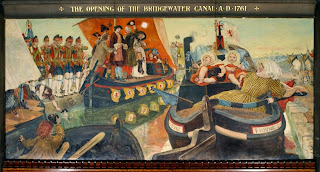The lunch dates were the final instalment in a series of events, performances and installations that have taken over seven non-art sites across Manchester and Salford since last August. Edwina Ashton hosted a fantastical tea party in a Salford tower block, and local artist Amber Sanchez took performance to the streets of a Salford estate. Imagined narratives were constructed around hotel guests and recounted by Giles Bailey to a small audience in a darkened hotel room, and a radio programme broadcast a new monument for Salford, which existed only as a composite compiled from Amy Feneck's survey of local residents' ideas.
Seven Sites was a collaboration between curator Laura Mansfield, who is interested in artist-led activity, and artist Swen Steinhauser, who has a background in contemporary devised theatre. Swen explained: “Visual arts in general has a fear of theatre. The two disciplines seem quite divided so we thought we should work on bringing them together.” For Swen, Seven Sites was a chance to be on the other side of art production – working on making it happen for artists, and for both it was a way of trying out durational programming – although, as Laura explains, the project has evolved: “It's become something really different and the rhythm has shifted with each piece. We were interested in doing something that's always shifting but still manages to be a programme.”
 The pair chose seven places of everyday public interaction, from the Lowry Outlet Mall to an outdated church cafeteria and the overwrought but shabby grandeur of the Britannia Hotel – a task that was harder than first thought, due to bureaucratic hurdles raised by insurance, security and noise. Seven artists (or groups) were invited to each produce a response to a site, primarily those who had not worked in Manchester before and who “weren't so easy to pinpoint and could work in more than one place”.
The pair chose seven places of everyday public interaction, from the Lowry Outlet Mall to an outdated church cafeteria and the overwrought but shabby grandeur of the Britannia Hotel – a task that was harder than first thought, due to bureaucratic hurdles raised by insurance, security and noise. Seven artists (or groups) were invited to each produce a response to a site, primarily those who had not worked in Manchester before and who “weren't so easy to pinpoint and could work in more than one place”.By presenting art and performance in places where neither are typically encountered, Seven Sites aimed to subvert the genre expectations of both audiences – at the same time as incorporating the preexisting users of these places, and those who were merely passing through. Laura explained: “I felt frustrated with being part of a certain community, and all the announcements of cuts presented an opportunity to do something outside of fixed spaces. The minute you fix something to a place you always get an expectation of a fixed audience. If you shift spaces you get a diverse audience. Two audiences meet with the general public in a place that's not their own.” Swen added: “ If you frame something it really alters your experience of something that's already there. Certain institutions are associated with a certain aesthetic. A gallery is such a safe environment. We wanted to take audiences away from a safe environment and bring people in to see work they wouldn't normally have seen.” Each instalment existed both on its own and as part of a series. Swen explained: “A single site is dependent on whoever comes and it is difficult to get a big audience outside of a tested institution. A series is less dependent on one occurrence of a big crowd. There was very little continuity of audience. Some people came to one or two but still got a sense of it as a series.”
Seven Sites required the audience to take a leap of faith, with each event advertised only with the barest of information – date, time, artist and location, its exact form remaining a secret until it took place. Laura admits: “Some of the audience thought it was some kind of city tour!” It was also a chance for artists to try something outside their usual practice, and for the curators to step back and be surprised, with the shape of the final work left up to the artist. Laura said: “Your expectations of who that artist could be were changed.” Speaking of Antonia Low, who transformed a serving hatch in a church into an idealised but unattainable white cube space, Laura said: “Antonia really put a spin on her own practice and did the opposite of what she usually does.” One of the most daring of the interventions took place during a regular pub comedy night where, unbeknown to the crowd, Seven Sites presented the comedy debut of Sian Robinson Davies – as Laura says, “She didn't have to worry about anyone coming!” Sian didn't want to be seen as an artist but as another comedian – and her awkward yet funny performance was well-received by regulars who didn't realise they were involved in an art performance. Sian now plans to do another comedy performance, in London.
Seven Sites was a reminder of the fantastical that can be found in the banal, the possibilities in the conversations that usually go unsaid, the potential for places to be transformed with a bit of imagination, and what you might find if you step outside your local and give new things a go.
Photos taken from the Seven Sites tumblr.
Laura Mansfield has curated the exhibition Triptych, which will run from 13-16 July at Three Piccadilly Place.










